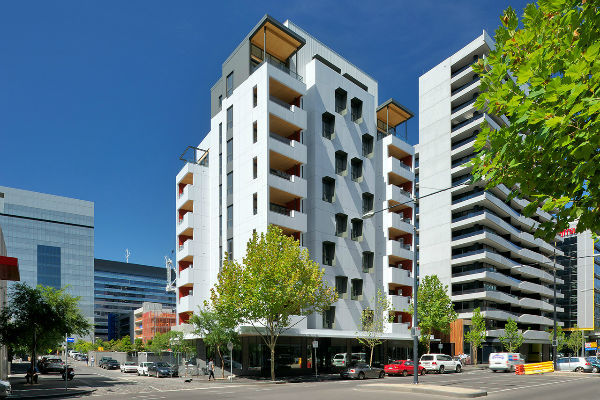5 milestones in high-rise wood building
- Henk De Vlaeminck
- 5 mar 2016
- Tempo di lettura: 5 min
Until a few years ago, most building codes around the world limited the height of wood structures to about 4 to 6 storeys. This not only blocked innovation and research, it resulted in an absurd throwback into the past.

18-storey building for the University of British Columbia, Canada.
Fortunately, things changed rapidly and now we are witnessing a worldwide race for the highest wood building. It is in some way comparable to the competitive spirit when about 100 years ago the first concrete and steel skyscrapers were popping up in New York and around the world. The dream of building higher and higher became a motivation to problem solving and a motivation to find new innovative technical solutions. Like Architect Michael Green, one of the main promoters of tall wood structures, would put it “BIG PROBLEMS = BIG OPPORTUNITIES”. In his latest book
published just a few days ago, Michael Green explains in 6 projects his focus on new timber technologies at all scales, from art installations to the world’s tallest wood buildings. A very inspiring book!

Stadthaus, Murray Grove, London - Photo Will Pryce
The race began in 2008 with what is considered the first high-rise wood building. The Stadthaus, Murray Grove building in London is a nine-storey housing project with twenty-nine apartments. The structure is a cross-laminated timber (CLT) panel system pioneered by manufacturers in Austria. It is the first building in the world of this height with not only load-bearing walls and floor slabs, but also stairs and lift cores entirely in timber.
Each panel can be up to 13m long and is prefabricated including cut-outs for windows and doors. As the panels arrived on site, they were immediately craned into position. The nine-storey wood structure was erected within nine weeks. The entire building was finished in January 2009.

Forte Living in Melbourne, Australia
The same building technique was used to build Forte Living in Melbourne, Australia. It is a 10 storey building (9 floors completely in wood) containing 23 apartments, with a total height of 32m. Once again the CLT panels were shipped in from Austria. The building site opened in February 2012 and the building was finished in December 2012. The building of the actual timber structure took 38 working days. The costs for a timber structure are slightly higher than steel or concrete structures, but are largely compensated by a shorter realisation time.
Just 2 years later, the height record was beaten by a Norwegian project. The building company Sweco had previously done some feasibility studies on tall timber buildings and they gathered lots of experience on smaller wood structures. This knowledge led to a 14-storey building in Bergen, Norway.

14-storey building in Bergen, Norway
The structure is based on a glulam truss system connected with slotted-in steel plates and dowels, a proven system for large timber structures. This way it was possible to realise a fire resistant structure, which can burn for 90 minutes without failing. To achieve this goal, there was no need of extra gypsum or other protection for the timber. Fire design was done according to the Eurocode, increasing the dimensions of the wood-elements and hiding all steel connections in the timber. Additionally there are sprinklers, pressurised escape stairs and painted surfaces to increase fire safety. Although CLT panels were used for the staircases and elevator shaft, they are not connected to the glulam structure, which forms the main load bearing system of this building.
Now that we reach the third continent for our fourth milestone, the race in high-rise wood building has more of a race around the globe. Canada is planning an 18-storey building for the University of British Columbia. The building will reach 53 m, will contain 272 studio apartments and 33 four-bedroom apartments for a total of 404 students.

18-storey building for the University of British Columbia, Canada
The choice for the structure is once again CLT panelling. These lightweight, environment-friendly panels are made of renewably managed sources; they are easy to transport and place on site. Using wood instead of steel or concrete not only prevents tonnes of carbon from entering the atmosphere, wood also absorbs carbon throughout its natural life and continues to store that carbon during the entire life cycle of the building. Using timber is definitely a sustainable choice.
The opening of the building is planned for September 2017, possible thanks to the short building time needed for this type of structure. However, it is not sure at all if this 18-storey building will set a record and for how long, as there is a 24-storey (84m high) landmark rising up in Vienna, Austria. The HoHo building site opens in spring 2016 and should be completed by the end of 2017 or beginning of 2018. The towers are hybrid structures with concrete stair and elevator towers as a reinforced core. Offices and other spaces around these towers are wood structures that bear their own weight. About 75% of the structures above the foundation are wood.

HoHo Vienna, Austria
“The starting point is to realise the building as efficiently as possible. We combine wood construction with concrete construction and with this synergy we strive for the best possible solution from the standpoint of building regulations, quality, cost-efficiency, fire safety and flexibility,” Architect Lainer explains.
As competitors get stronger, it is getting tougher to have the highest wood building in the world and to keep that record for a reasonable time. This race is important because it is an enormous boost for research on timber and a real public opinion changer. It blows away - once for all - the dust of the timber industry and clearly highlights the progress made in the last decade of modern timber building. Nevertheless, like in real life, participating is more important than winning. Wood as a building material has so many benefits for the environment, our living comfort, energy saving, time efficiency during construction, carbon storage, etc. that there is really no loser in this competition. Constructing in wood is a win-win situation, no matter the size!
Tell us about your personal record in wood construction. Or what subject would you like to see explained in one of our future posts?
For further information:
"MG.6: Six Architectural Projects" by Michael Green – March 1, 2016
“Michael Green: Why we should build wooden skyscrapers”, TED Talks, Youtube, 09/07/2013.
“Forte` - Creating the World's Tallest CLT Apartment Building”, reThinkWood,Youtube, 20/09/2013.
#woodstructure #milestone #highrise #race #woodscraper #MichaelGreen #Stadthaus #MurrayGrovebuilding #London #CLT #crosslaminated #panelsystem #Austria #timber #timberbuilding #timberconstruction #ForteLiving #Melbourne #Australia #Bergen #Norway #glulam #glulamtrusssystem #fireresistant #firedesign #XLAM #UniversityofBritishColumbia #Canada #lightweight #environmentfriendly #carbon #HoHo #HoHoWien #Vienna #hybridstructure #timberindustry #environment #livingcomfort #energysaving #timeefficiency #carbonstorage



































Comments